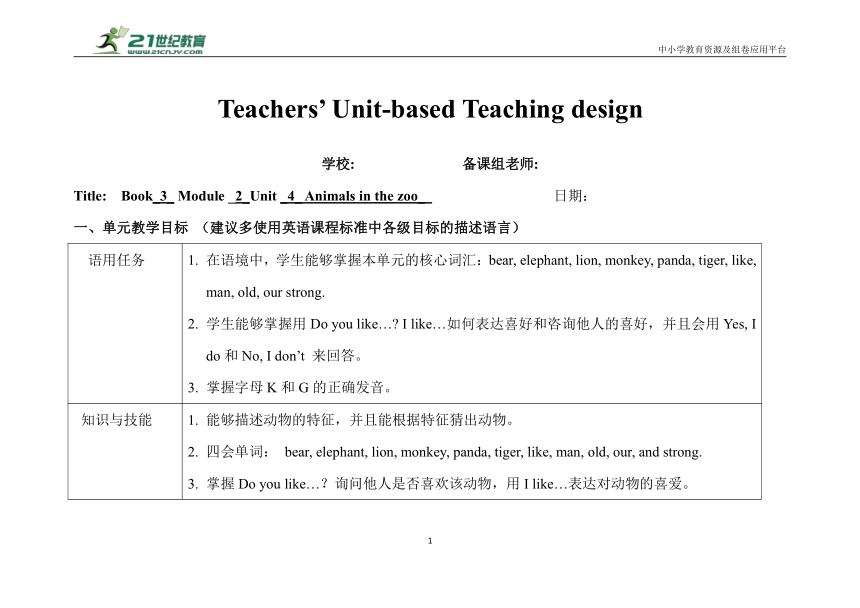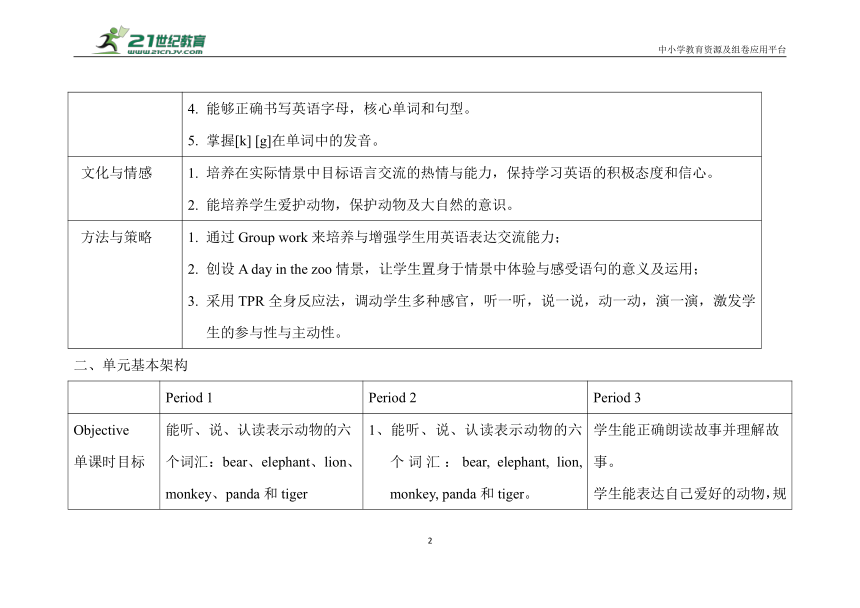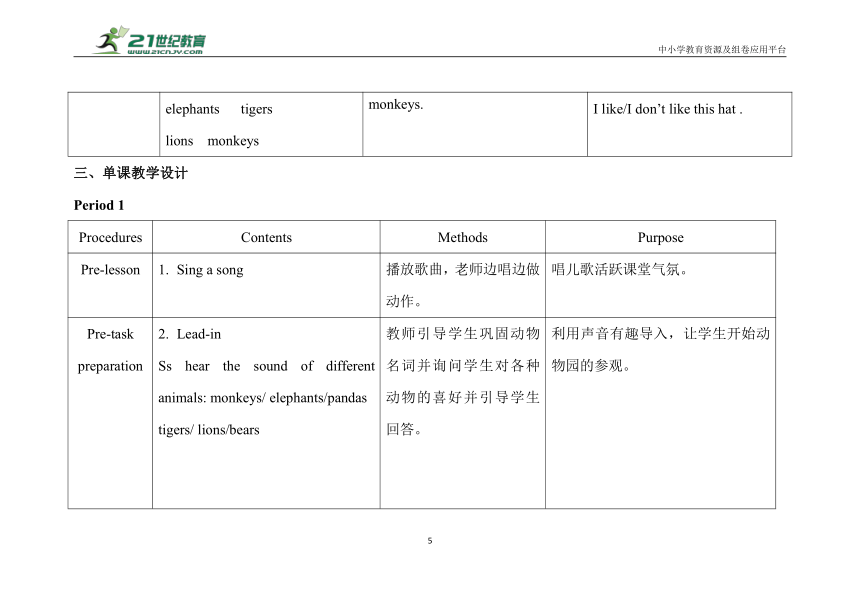三年级下册第四单元整体教学设计
图片预览





文档简介
中小学教育资源及组卷应用平台
Teachers’ Unit-based Teaching design
学校: 备课组老师:
Title: Book_3_ Module _2_Unit _4_ Animals in the zoo_ 日期:
一、单元教学目标 (建议多使用英语课程标准中各级目标的描述语言)
语用任务 在语境中,学生能够掌握本单元的核心词汇:bear, elephant, lion, monkey, panda, tiger, like, man, old, our strong. 学生能够掌握用Do you like… I like…如何表达喜好和咨询他人的喜好,并且会用Yes, I do和No, I don’t 来回答。 掌握字母K和G的正确发音。
知识与技能 能够描述动物的特征,并且能根据特征猜出动物。 四会单词: bear, elephant, lion, monkey, panda, tiger, like, man, old, our, and strong. 掌握Do you like…?询问他人是否喜欢该动物,用I like…表达对动物的喜爱。 能够正确书写英语字母,核心单词和句型。 掌握[k] [g]在单词中的发音。
文化与情感 培养在实际情景中目标语言交流的热情与能力,保持学习英语的积极态度和信心。 能培养学生爱护动物,保护动物及大自然的意识。
方法与策略 通过Group work来培养与增强学生用英语表达交流能力; 创设A day in the zoo情景,让学生置身于情景中体验与感受语句的意义及运用; 采用TPR全身反应法,调动学生多种感官,听一听,说一说,动一动,演一演,激发学生的参与性与主动性。
二、单元基本架构
Period 1 Period 2 Period 3
Objective 单课时目标 能听、说、认读表示动物的六个词汇:bear、elephant、lion、monkey、panda和tiger 学生能听懂关于喜欢和不喜欢某种动物的对话。 学生能用I like/don’t like…表达对某种动物喜欢与否。 学生能用Do you like… 来询问别人的喜好并能用Yes, I do./No, I don’t.来回答别人的提问。 1、能听、说、认读表示动物的六个词汇:bear, elephant, lion, monkey, panda和tiger。 2、能听懂、会说句型Do you like… Yes, I do. /No, I don’t. 并能在生活中使用这些句型来询问他人的喜好。 学生能正确朗读故事并理解故事。 学生能表达自己爱好的动物,规范书写及完成短文。 学生能用通过故事学习阅读的方法,并学会用形容词进行总结。
Topic 单课时话题 Let’s go to the zoo. Animals I like The old man and the monkeys.
Content 单课时教学文本 Look at the monkeys. They’re cute. I like monkeys. Do you like monkeys, Ben No, I don’t. I like elephants. They’re big and strong. Do you like elephants, kitty Yes, I do. The old man: Oh, it’s hot. It’s cool here. Monkey1:Look! What’s this Monkey2: It’s a hat. Monkey3: I like this hat. The old man: They’re my hats! Monkeys: They’re our hats. The old man: I don’t like this hat! Monkeys: I don’t like this hat.
Blackboard design 板书设计 Let’s go to the zoo. Do you like… I like/don’t like… bears pandas elephants tigers lions monkeys Animals I like I like bears. Do you like bears Yes, I do./ No, I don’t . I like monkeys. 《The old man and the monkeys》 Whose hats are they my our I like/I don’t like this hat .
三、单课教学设计
Period 1
Procedures Contents Methods Purpose
Pre-lesson Sing a song 播放歌曲,老师边唱边做动作。 唱儿歌活跃课堂气氛。
Pre-task preparation Lead-in Ss hear the sound of different animals: monkeys/ elephants/pandas tigers/ lions/bears 教师引导学生巩固动物名词并询问学生对各种动物的喜好并引导学生回答。 利用声音有趣导入,让学生开始动物园的参观。
While-task procedure Watch a video T ask question: What animals is it Play the video Ss answer the question and do the role play Listen and circle Watch, read and choose. Make a riddle Look and guess Read and follow 学生看视频并且回答问题,然后分角色朗读课文。播放动物声音,考察学生认知能力。 通过听、观看视频、读等多种方式感知文本。同时,在情境中习得词汇, 学生选择自己喜欢的动物并描述,说出来让同学猜。 组织学生跟读课文,培养学生思考并解决问题的能力。让学生感知新单词和学习文本,对语言的学习采取循序渐进的方法。并通过跟读,增强学生的输出。
Post-task activity 1. Act the dialogue 2. Ask question: What animal do you like 跟读并表演对话。 发展自主学习能力和合作精神。
Assignment 1.Finish copy book. 2. Listen to the CD. 3. Retell the story
Period 2
Procedures Contents Methods Purpose
Pre-lesson Greeting Listen to a song: At the Zoo. Brain Storming T: Hello, boys and girls, please listen to the song. What animals can you hear S: I can hear a … T: Can you say any other animals S: Chicken, dog… 听歌曲记动物单词。 头脑风暴说动物
Pre-task preparation 1、自己尝试认读单词bear, elephant, lion, monkey, panda和tiger。 2、自由轻声读课文 bear, elephant, lion, monkey, panda和tiger (教材18页Listen and say)。 要求:发音要准确。
While-task procedure 1、哪些不理解的词句,同桌交流。 2、小组合作。 3、讨论交流不理解的词句。 4、老师进行指导。 结合课文图片,听录音,读句子,尝试翻译英语句子。 Do you like… 你喜欢……? cute是聪明伶俐的意思
Post-task activity 1、听写单词。 2、选词填空。 I _____pandas. A. like B. am I _____ like lions. A. don’t B. no ______you like giraffes A. Are B. Do I like ______ A. bear B. bears 语法练习
Assignment 用所学英语句型Do you like… 来询问他人的喜好。 活动手册unit4.
Period 3
Procedures Contents Methods Purpose
Pre-lesson Sing a phonics song Review the “k” “g” words 学生唱自然拼读歌,并且复习“k”和“g” 发音的单词 通过复习26个字母的发音,调动学习积极性,并学习“k”和“g”的发音。
Pre-task preparation Ask and answer T:Do you like …s Ss: Yes, I do. No, I don’t. I like …s. 师生对话操练本单元的重点句型。 通过问答,巩固本单词与句子。
While-task procedure Look and think T: what do you see Ss: I can see… Listen and answer T: What season is it How is the weather Do the monkeys like the hats Listen and order Read and think Read and follow 提问题来加深对故事的理解。给故事排序培养学生的听力能力和逻辑思维。 通过观看视频让学生感知故事人物的表情和动作。通过故事学习核心词汇和句型。通过讨论老人是否喜欢帽子,让学生理解故事的真正含义。
Post-task activity 1.Act out the story 2.Change the story The old mand says: “We’re friends. Give the hats to you.” 边表演边配上动作去表演,活泼有趣,并改编故事提高学生兴趣。 回归课本,复述故事。然后通过改编故事,锻炼学生的思维,并让这个故事更加有趣。
Assignment Act out the story. Review the “k” “g” words
注:5-6年级按4课时编写。谢谢!
四、阅读素养评价
A
Hello. I’m Tom. I’m at the zoo(动物园). Look at the tiger. This is a small tiger. It has a long nose. Who’s singing Oh, it’s the bird in the tree. It’s yellow.
阅读短文,判断正(T)误(F)
( )1. I’m at the zoo.
( )2. This is a big tiger.
( )3. It has a long nose.
( )4. The bird in the sky is singing.
B
I have a cat . It is a lovely(可爱的) cat. Her name is Dongdong. Her fur(毛)is black and white. She is my best friend. I like her very much . I often tell stories(故事)to her .
根据短文内容判断正(T),(F)
( )1. I have a dog .
( )2. Her name is Tom.
( )3. She is my best friend.
( )4. I don’t like her.
( )5. I often tell stories to her.
C
阅读对话,判断句子正(T)误(F).
Mum:Taste the juice,please!
Mary:Thank you,Mum.It’s sweet.
Mum:Today is sunny.Let’s go to the zoo.
Mary:Oh,I’m very happy.Let’s go!
Mum:Do you like monkeys
Mary:Yes,I do.The monkeys are cute.
Mum:Do you like elephants
Mary:No,I don’t.They’re big and strong.
Mum:What colour is the panda
Mary:It’s black and white.It’s cute,too.
( ) Mary tastes the juice.
( ) Mary likes monkeys.
( ) Mary likes elephants.
( ) The panda is black.
( ) Mary and Mum go to the zoo.
D
Look at me.I’m a beautiful girl.My face is round.My eyes are big.My nose is small.My mouth is red.I have long hair.My hair is black.My arms are thin and my legs are long.I like my dress
1. Her face is .
2. Her eyes are .
3.Her nose is .
4.Her mouth is .
5.Her legs are .
四、教学设计说明:
本节课的教学内容是动物园的动物,这个话题对于三年级的孩子来说并不陌生,因为在3a教材中我们已接触过一些猫、 狗之类的常见动物。三年级的孩子活泼好动,他们大多喜欢动物,对野生动物也充满探索的兴趣,再加上动画片中可爱的卡通动物形象,学生会更加乐于参与教学活动的。
1.情境导学。在本节课中我创设了“参观动物园”这样一个情境,并贯穿整个课堂。上课伊始,通过“What can you hear ”这样一个话题引导学生复习已学过的动物单词。然后,通过“看更多的动物”引出情境“visit the zoo(参观动物园)”。接下来通过多媒体演示活泼可爱的动物来学习新的动物单词。为了让学生更好的掌握新句型:“I like … Do you like … ” “Yes, I do./ I don’t. I like …”,我特意在设计课件时加入了孩子们喜闻乐见的卡通人物形象:、、等,让他们来扮演这些角色,进而激发学生交流的欲望。熟悉的卡通形象,新鲜有趣的卡通图片,仿佛就学生置身于动画片之中,使得他们更有欲望用英语去表达自己,对话也更真实可信。最后结课时,通过之口教育学生要爱护动物,达到寓教于乐的目的。
2. 任务教学法与合作学习
在本节课中,我设计了一个“争当小小英文导游”的任务,要求学生运用所学知识解决现实问题。在这个活动中,我设计了三个关卡:(1)、连一连。这个任务要求学生独立完成,主要考察学生对单词的掌握情况。(2)、说一说。这个任务要求学生两两合作完成,主要考察学生对句型的掌握情况。(3)、演一演。这个任务要求学生在四人小组内完成,主要考察学生对所学知识的应用能力。在这些任务中,我只起到一个活动的组织者、指导者的作用,而学生则是真正的参与者,在这个任务中他们必须明确自己的目标,必须想办法与同学交流才能完成任务,充分发挥了他们的主体地位。
3、多元评价
在教学过程中注重对学生的个人评价与小组评价。设立了“五星级英文小导游”评选活动与“五星级旅游团”评选活动。
4.教学建议
建议选取的阅读内容与单元主题、单课时话题相关,根据学生的特点,为不同层次的学生选择不同的阅读材料,鼓励选取故事、对话、诗歌等不同形式的阅读材料,避免因为阅读材料太难而降低学生学习英语的兴趣; 建议老师参考国外原版阅读材料、绘本等资源,语篇语言尽可能地道;在提供阅读体验的同时注重阅读习惯的培养,建议老师对阅读能力的考查设计不同类型的题型,对阅读理解类型提供做题方法和技巧的指导。
五、推荐阅读
18
Teachers’ Unit-based Teaching design
学校: 备课组老师:
Title: Book_3_ Module _2_Unit _4_ Animals in the zoo_ 日期:
一、单元教学目标 (建议多使用英语课程标准中各级目标的描述语言)
语用任务 在语境中,学生能够掌握本单元的核心词汇:bear, elephant, lion, monkey, panda, tiger, like, man, old, our strong. 学生能够掌握用Do you like… I like…如何表达喜好和咨询他人的喜好,并且会用Yes, I do和No, I don’t 来回答。 掌握字母K和G的正确发音。
知识与技能 能够描述动物的特征,并且能根据特征猜出动物。 四会单词: bear, elephant, lion, monkey, panda, tiger, like, man, old, our, and strong. 掌握Do you like…?询问他人是否喜欢该动物,用I like…表达对动物的喜爱。 能够正确书写英语字母,核心单词和句型。 掌握[k] [g]在单词中的发音。
文化与情感 培养在实际情景中目标语言交流的热情与能力,保持学习英语的积极态度和信心。 能培养学生爱护动物,保护动物及大自然的意识。
方法与策略 通过Group work来培养与增强学生用英语表达交流能力; 创设A day in the zoo情景,让学生置身于情景中体验与感受语句的意义及运用; 采用TPR全身反应法,调动学生多种感官,听一听,说一说,动一动,演一演,激发学生的参与性与主动性。
二、单元基本架构
Period 1 Period 2 Period 3
Objective 单课时目标 能听、说、认读表示动物的六个词汇:bear、elephant、lion、monkey、panda和tiger 学生能听懂关于喜欢和不喜欢某种动物的对话。 学生能用I like/don’t like…表达对某种动物喜欢与否。 学生能用Do you like… 来询问别人的喜好并能用Yes, I do./No, I don’t.来回答别人的提问。 1、能听、说、认读表示动物的六个词汇:bear, elephant, lion, monkey, panda和tiger。 2、能听懂、会说句型Do you like… Yes, I do. /No, I don’t. 并能在生活中使用这些句型来询问他人的喜好。 学生能正确朗读故事并理解故事。 学生能表达自己爱好的动物,规范书写及完成短文。 学生能用通过故事学习阅读的方法,并学会用形容词进行总结。
Topic 单课时话题 Let’s go to the zoo. Animals I like The old man and the monkeys.
Content 单课时教学文本 Look at the monkeys. They’re cute. I like monkeys. Do you like monkeys, Ben No, I don’t. I like elephants. They’re big and strong. Do you like elephants, kitty Yes, I do. The old man: Oh, it’s hot. It’s cool here. Monkey1:Look! What’s this Monkey2: It’s a hat. Monkey3: I like this hat. The old man: They’re my hats! Monkeys: They’re our hats. The old man: I don’t like this hat! Monkeys: I don’t like this hat.
Blackboard design 板书设计 Let’s go to the zoo. Do you like… I like/don’t like… bears pandas elephants tigers lions monkeys Animals I like I like bears. Do you like bears Yes, I do./ No, I don’t . I like monkeys. 《The old man and the monkeys》 Whose hats are they my our I like/I don’t like this hat .
三、单课教学设计
Period 1
Procedures Contents Methods Purpose
Pre-lesson Sing a song 播放歌曲,老师边唱边做动作。 唱儿歌活跃课堂气氛。
Pre-task preparation Lead-in Ss hear the sound of different animals: monkeys/ elephants/pandas tigers/ lions/bears 教师引导学生巩固动物名词并询问学生对各种动物的喜好并引导学生回答。 利用声音有趣导入,让学生开始动物园的参观。
While-task procedure Watch a video T ask question: What animals is it Play the video Ss answer the question and do the role play Listen and circle Watch, read and choose. Make a riddle Look and guess Read and follow 学生看视频并且回答问题,然后分角色朗读课文。播放动物声音,考察学生认知能力。 通过听、观看视频、读等多种方式感知文本。同时,在情境中习得词汇, 学生选择自己喜欢的动物并描述,说出来让同学猜。 组织学生跟读课文,培养学生思考并解决问题的能力。让学生感知新单词和学习文本,对语言的学习采取循序渐进的方法。并通过跟读,增强学生的输出。
Post-task activity 1. Act the dialogue 2. Ask question: What animal do you like 跟读并表演对话。 发展自主学习能力和合作精神。
Assignment 1.Finish copy book. 2. Listen to the CD. 3. Retell the story
Period 2
Procedures Contents Methods Purpose
Pre-lesson Greeting Listen to a song: At the Zoo. Brain Storming T: Hello, boys and girls, please listen to the song. What animals can you hear S: I can hear a … T: Can you say any other animals S: Chicken, dog… 听歌曲记动物单词。 头脑风暴说动物
Pre-task preparation 1、自己尝试认读单词bear, elephant, lion, monkey, panda和tiger。 2、自由轻声读课文 bear, elephant, lion, monkey, panda和tiger (教材18页Listen and say)。 要求:发音要准确。
While-task procedure 1、哪些不理解的词句,同桌交流。 2、小组合作。 3、讨论交流不理解的词句。 4、老师进行指导。 结合课文图片,听录音,读句子,尝试翻译英语句子。 Do you like… 你喜欢……? cute是聪明伶俐的意思
Post-task activity 1、听写单词。 2、选词填空。 I _____pandas. A. like B. am I _____ like lions. A. don’t B. no ______you like giraffes A. Are B. Do I like ______ A. bear B. bears 语法练习
Assignment 用所学英语句型Do you like… 来询问他人的喜好。 活动手册unit4.
Period 3
Procedures Contents Methods Purpose
Pre-lesson Sing a phonics song Review the “k” “g” words 学生唱自然拼读歌,并且复习“k”和“g” 发音的单词 通过复习26个字母的发音,调动学习积极性,并学习“k”和“g”的发音。
Pre-task preparation Ask and answer T:Do you like …s Ss: Yes, I do. No, I don’t. I like …s. 师生对话操练本单元的重点句型。 通过问答,巩固本单词与句子。
While-task procedure Look and think T: what do you see Ss: I can see… Listen and answer T: What season is it How is the weather Do the monkeys like the hats Listen and order Read and think Read and follow 提问题来加深对故事的理解。给故事排序培养学生的听力能力和逻辑思维。 通过观看视频让学生感知故事人物的表情和动作。通过故事学习核心词汇和句型。通过讨论老人是否喜欢帽子,让学生理解故事的真正含义。
Post-task activity 1.Act out the story 2.Change the story The old mand says: “We’re friends. Give the hats to you.” 边表演边配上动作去表演,活泼有趣,并改编故事提高学生兴趣。 回归课本,复述故事。然后通过改编故事,锻炼学生的思维,并让这个故事更加有趣。
Assignment Act out the story. Review the “k” “g” words
注:5-6年级按4课时编写。谢谢!
四、阅读素养评价
A
Hello. I’m Tom. I’m at the zoo(动物园). Look at the tiger. This is a small tiger. It has a long nose. Who’s singing Oh, it’s the bird in the tree. It’s yellow.
阅读短文,判断正(T)误(F)
( )1. I’m at the zoo.
( )2. This is a big tiger.
( )3. It has a long nose.
( )4. The bird in the sky is singing.
B
I have a cat . It is a lovely(可爱的) cat. Her name is Dongdong. Her fur(毛)is black and white. She is my best friend. I like her very much . I often tell stories(故事)to her .
根据短文内容判断正(T),(F)
( )1. I have a dog .
( )2. Her name is Tom.
( )3. She is my best friend.
( )4. I don’t like her.
( )5. I often tell stories to her.
C
阅读对话,判断句子正(T)误(F).
Mum:Taste the juice,please!
Mary:Thank you,Mum.It’s sweet.
Mum:Today is sunny.Let’s go to the zoo.
Mary:Oh,I’m very happy.Let’s go!
Mum:Do you like monkeys
Mary:Yes,I do.The monkeys are cute.
Mum:Do you like elephants
Mary:No,I don’t.They’re big and strong.
Mum:What colour is the panda
Mary:It’s black and white.It’s cute,too.
( ) Mary tastes the juice.
( ) Mary likes monkeys.
( ) Mary likes elephants.
( ) The panda is black.
( ) Mary and Mum go to the zoo.
D
Look at me.I’m a beautiful girl.My face is round.My eyes are big.My nose is small.My mouth is red.I have long hair.My hair is black.My arms are thin and my legs are long.I like my dress
1. Her face is .
2. Her eyes are .
3.Her nose is .
4.Her mouth is .
5.Her legs are .
四、教学设计说明:
本节课的教学内容是动物园的动物,这个话题对于三年级的孩子来说并不陌生,因为在3a教材中我们已接触过一些猫、 狗之类的常见动物。三年级的孩子活泼好动,他们大多喜欢动物,对野生动物也充满探索的兴趣,再加上动画片中可爱的卡通动物形象,学生会更加乐于参与教学活动的。
1.情境导学。在本节课中我创设了“参观动物园”这样一个情境,并贯穿整个课堂。上课伊始,通过“What can you hear ”这样一个话题引导学生复习已学过的动物单词。然后,通过“看更多的动物”引出情境“visit the zoo(参观动物园)”。接下来通过多媒体演示活泼可爱的动物来学习新的动物单词。为了让学生更好的掌握新句型:“I like … Do you like … ” “Yes, I do./ I don’t. I like …”,我特意在设计课件时加入了孩子们喜闻乐见的卡通人物形象:、、等,让他们来扮演这些角色,进而激发学生交流的欲望。熟悉的卡通形象,新鲜有趣的卡通图片,仿佛就学生置身于动画片之中,使得他们更有欲望用英语去表达自己,对话也更真实可信。最后结课时,通过之口教育学生要爱护动物,达到寓教于乐的目的。
2. 任务教学法与合作学习
在本节课中,我设计了一个“争当小小英文导游”的任务,要求学生运用所学知识解决现实问题。在这个活动中,我设计了三个关卡:(1)、连一连。这个任务要求学生独立完成,主要考察学生对单词的掌握情况。(2)、说一说。这个任务要求学生两两合作完成,主要考察学生对句型的掌握情况。(3)、演一演。这个任务要求学生在四人小组内完成,主要考察学生对所学知识的应用能力。在这些任务中,我只起到一个活动的组织者、指导者的作用,而学生则是真正的参与者,在这个任务中他们必须明确自己的目标,必须想办法与同学交流才能完成任务,充分发挥了他们的主体地位。
3、多元评价
在教学过程中注重对学生的个人评价与小组评价。设立了“五星级英文小导游”评选活动与“五星级旅游团”评选活动。
4.教学建议
建议选取的阅读内容与单元主题、单课时话题相关,根据学生的特点,为不同层次的学生选择不同的阅读材料,鼓励选取故事、对话、诗歌等不同形式的阅读材料,避免因为阅读材料太难而降低学生学习英语的兴趣; 建议老师参考国外原版阅读材料、绘本等资源,语篇语言尽可能地道;在提供阅读体验的同时注重阅读习惯的培养,建议老师对阅读能力的考查设计不同类型的题型,对阅读理解类型提供做题方法和技巧的指导。
五、推荐阅读
18
同课章节目录
- Module 1 Using my five senses.
- Unit 1 Colours
- Unit 2 Tastes
- Unit 3 Sounds
- Revision 1
- Project 1
- Module 2 My favourite things.
- Unit 4 Animals in the zoo
- Unit 5 Toys
- Unit 6 Food and drinKs
- Revision 2
- Project 2
- Module 3 My colourful life.
- Unit 7 Hobbies
- Unit 8 Happy birthday!
- Unit 9 A day on the farm.
- Revision 3
- Project 3
- Module 4 Things we enjoy.
- Unit 10 Funny cartoons
- Unit 11 Mother's Day
- Unit 12 Three little pigs
- Project 4
